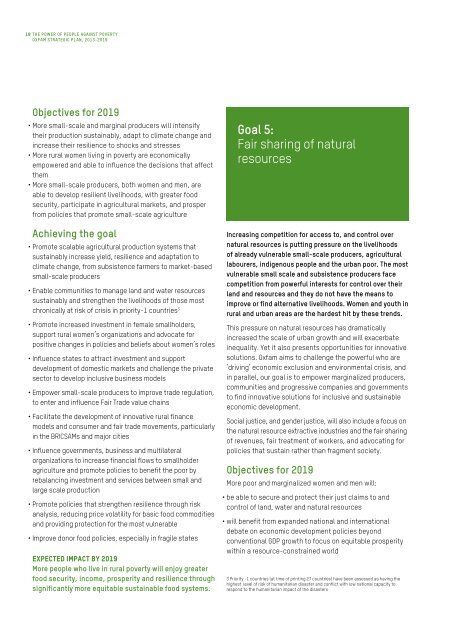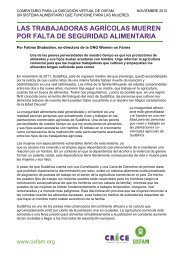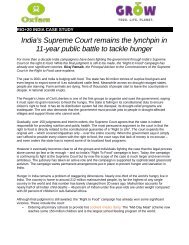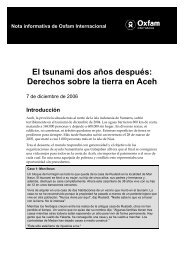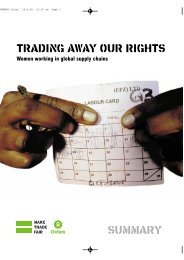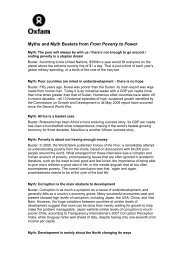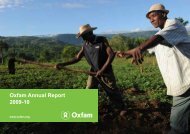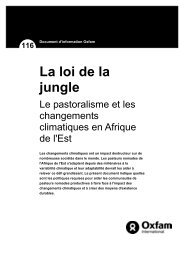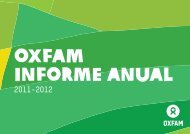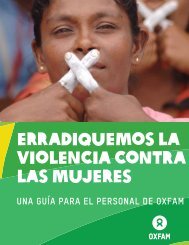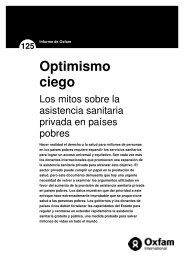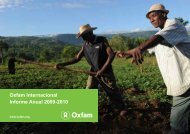Oxfam Strategic Plan, 2013-2019 - Oxfam International
Oxfam Strategic Plan, 2013-2019 - Oxfam International
Oxfam Strategic Plan, 2013-2019 - Oxfam International
You also want an ePaper? Increase the reach of your titles
YUMPU automatically turns print PDFs into web optimized ePapers that Google loves.
18 THE POWER OF PEOPLE AGAINST POVERTY<br />
OXFAM STRATEGIC PLAN, <strong>2013</strong>-<strong>2019</strong><br />
Objectives for <strong>2019</strong><br />
• More small-scale and marginal producers will intensify<br />
their production sustainably, adapt to climate change and<br />
increase their resilience to shocks and stresses<br />
• More rural women living in poverty are economically<br />
empowered and able to influence the decisions that affect<br />
them<br />
• More small-scale producers, both women and men, are<br />
able to develop resilient livelihoods, with greater food<br />
security, participate in agricultural markets, and prosper<br />
from policies that promote small-scale agriculture<br />
Achieving the goal<br />
• Promote scalable agricultural production systems that<br />
sustainably increase yield, resilience and adaptation to<br />
climate change, from subsistence farmers to market-based<br />
small-scale producers<br />
• Enable communities to manage land and water resources<br />
sustainably and strengthen the livelihoods of those most<br />
chronically at risk of crisis in priority-1 countries 3<br />
• Promote increased investment in female smallholders,<br />
support rural women’s organizations and advocate for<br />
positive changes in policies and beliefs about women’s roles<br />
• Influence states to attract investment and support<br />
development of domestic markets and challenge the private<br />
sector to develop inclusive business models<br />
• Empower small-scale producers to improve trade regulation,<br />
to enter and influence Fair Trade value chains<br />
• Facilitate the development of innovative rural finance<br />
models and consumer and fair trade movements, particularly<br />
in the BRICSAMs and major cities<br />
• Influence governments, business and multilateral<br />
organizations to increase financial flows to smallholder<br />
agriculture and promote policies to benefit the poor by<br />
rebalancing investment and services between small and<br />
large scale production<br />
• Promote policies that strengthen resilience through risk<br />
analysis, reducing price volatility for basic food commodities<br />
and providing protection for the most vulnerable<br />
• Improve donor food policies, especially in fragile states<br />
Expected impact by <strong>2019</strong><br />
More people who live in rural poverty will enjoy greater<br />
food security, income, prosperity and resilience through<br />
significantly more equitable sustainable food systems.<br />
Goal 5:<br />
Fair sharing of natural<br />
resources<br />
Increasing competition for access to, and control over<br />
natural resources is putting pressure on the livelihoods<br />
of already vulnerable small-scale producers, agricultural<br />
labourers, indigenous people and the urban poor. The most<br />
vulnerable small scale and subsistence producers face<br />
competition from powerful interests for control over their<br />
land and resources and they do not have the means to<br />
improve or find alternative livelihoods. Women and youth in<br />
rural and urban areas are the hardest hit by these trends.<br />
This pressure on natural resources has dramatically<br />
increased the scale of urban growth and will exacerbate<br />
inequality. Yet it also presents opportunities for innovative<br />
solutions. <strong>Oxfam</strong> aims to challenge the powerful who are<br />
‘driving’ economic exclusion and environmental crisis, and<br />
in parallel, our goal is to empower marginalized producers,<br />
communities and progressive companies and governments<br />
to find innovative solutions for inclusive and sustainable<br />
economic development.<br />
Social justice, and gender justice, will also include a focus on<br />
the natural resource extractive industries and the fair sharing<br />
of revenues, fair treatment of workers, and advocating for<br />
policies that sustain rather than fragment society.<br />
Objectives for <strong>2019</strong><br />
More poor and marginalized women and men will:<br />
• be able to secure and protect their just claims to and<br />
control of land, water and natural resources<br />
• will benefit from expanded national and international<br />
debate on economic development policies beyond<br />
conventional GDP growth to focus on equitable prosperity<br />
within a resource-constrained world<br />
3 Priority -1 countries (at time of printing 27 countries) have been assessed as having the<br />
highest level of risk of humanitarian disaster and conflict with low national capacity to<br />
respond to the humanitarian impact of the disasters


